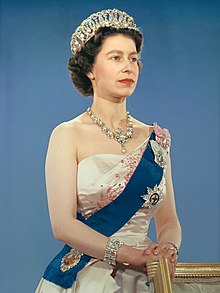
Back ملكه حاكمه ARZ Reynang reynante BCL Reina regnant Catalan Regerende dronning Danish Reina reinante Spanish Valitsev kuninganna Estonian ملکه حاکم Persian Sarauniya Hausa Regina regnante Italian 女王 Japanese
This article needs additional citations for verification. (December 2011) |
| Part of the Politics series |
| Monarchy |
|---|
 |
|
|
| Part of a series on |
| Imperial, royal, noble, gentry and chivalric ranks in Europe |
|---|
 |

A queen regnant (pl.: queens regnant) is a female monarch, equivalent in rank, title and position to a king. She reigns suo jure (in her own right) over a realm known as a kingdom; as opposed to a queen consort, who is married to a reigning king; or a queen regent, who is the guardian of a child monarch and rules pro tempore in the child's stead or instead of her husband who is absent from the realm, be it de jure in sharing power or de facto in ruling alone. A queen regnant is sometimes called a woman king.[1][2] A princess regnant is a female monarch who reigns suo jure over a principality; an empress regnant is a female monarch who reigns suo jure over an empire.
A queen regnant possesses and exercises sovereign powers, whereas a queen consort or queen regent shares her spouse's or child's rank and titles but does not share the sovereignty of her spouse or child. The husband of a queen regnant traditionally does not share the queen regnant's rank, title, or sovereignty. However, the concept of a king consort or prince consort is not unheard of in both contemporary and historical periods.
A queen dowager or empress dowager is the widow of a king or emperor; a queen mother is a queen dowager who is also the mother of a reigning sovereign.
Since the abdication of Margrethe II of Denmark on 14 January 2024, there are currently no female sovereigns in the world. This is the first time this has been the case in over 200 years.
- ^ Jason Thompson (2015). Wonderful Things – A History of Egyptology – Volume 2 – The Golden Age: 1881–1914. American University in Cairo Press. p. 16.
- ^ Parvin Torkamany Azar (February 2010). "The Author's Attitude of the Book 'Tarikh-i-Shahi' on Women Kings". Journal of Woman in Culture Arts. 1 (2). 148774.
© MMXXIII Rich X Search. We shall prevail. All rights reserved. Rich X Search